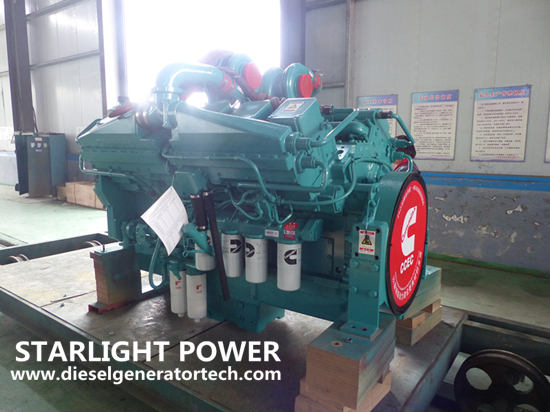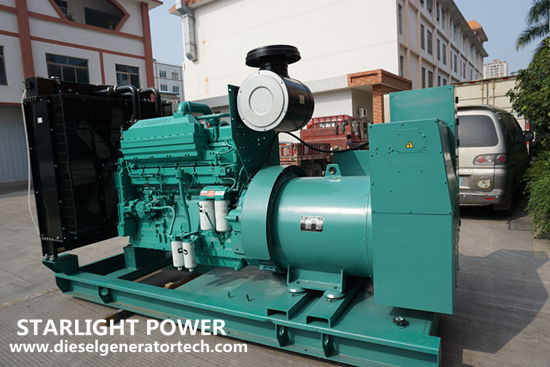Do you know about fuel combustion process of Cummins diesel generator cylinder? If not, let us read this article, you will find answers here.
According to the characteristics of variation of gas pressure and temperature in cylinder, the combustion process of Cummins diesel generator generally can be divided into four stages: delayed combustion period, rapid combustion period, slow combustion period and after combustion period. In these four stages, the specific performance of each combustion stage is different.

Here we take everyone to understand the performance of each combustion stage, so as to help users figure out what kind of working status of the diesel generator set is in.
1.Delayed combustion period.
From the beginning of oil injection to ignition is called delayed combustion period. This is the physical preparation of the injected fuel for atomization, heating, evaporation, diffusion, mixing with air, etc. In generally, the delayed combustion period is 0.0007~0.003s.
Delayed combustion period has a great impact on the operation of diesel engines. The longer this period, the more fuel is injected into the combustion chamber, the faster the pressure in the cylinder rises. Although this can slightly improve the economy, but it increases the roughness of the engine work and accelerates the wear and tear of the machine. Therefore, the general diesel engine would rather sacrifice some economy, but also let its work smoothly.
The main impact factor of delayed combustion period is the quality of diesel fuel, temperature and pressure at the end of compression and air vortex in combustor etc..
2.Rapid combustion period.
The period from the start of fuel ignition to the moment of rapid combustion and the highest pressure is called the rapid combustion period. The characteristics of the period is high heat release rate (dQ/dч), fast increase of pressure and temperature in cylinder. Its pressure rise rate depends on the quantity of combustible gas mixture which formed during delayed combustion period. In order to let diesel engine stable work, max. pressure rise rate (dQ/dч) should be not more than 0.40~0.60MPa/℃A.
3.Slow combustion period.
The slow-burning period is the period from the highest pressure to the highest temperature. The characteristic of this period is that the combustion is carried out under the condition that the cylinder volume is increasing, which is mainly controlled by the formation speed of the mixed gas, and the burning speed is slower than the rapid burning period, The gas temperature rose to a maximum of 1973~2273K, but the pressure dropped slightly. At the end of the slow-burning period, the amount of heat released generally reaches 70% to 80% of the total heat of circulation.
4.After combustion period.
The after combustion period is a period from the highest temperature point to the end of combustion. This period is characterized by burning on the expansion line. At this time, the oxygen is greatly reduced, the heat release rate is lowered, and the heat released by the fuel cannot be effectively utilized, thereby increasing the exhaust gas temperature and reducing the economy. At the end of after combustion, the heat release rate has reached 96%~98% of the total circulation heat release rate. The higher the speed of diesel engine, the longer the after combustion period.
The burning speed of after combustion period is very slow, and the piston has been far from the top dead point, the capacity of cylinder has increased too much, at this time, the temperature and pressure in the cylinder are rapidly declining. Therefore, the heat released during the after combustion period is not only difficult to use, but also increases the heat load of the parts, increases the exhaust temperature, increases the cooling heat loss, and reduces the economic efficiency of the diesel engine. Therefore, the shorter the after burning period is the better.
The main factors affecting combustion process are structural factors and operational factors. The main structural factors are compression ratio, combustion chamber, intake port, structure form of fuel injection pump and injector, and injection law, etc. The main operating factors are diesel oil performance, injection advance angle, injection pressure, load and speed etc.
In order to improve the formation conditions of combustible mixture gases, reasonable combustion is adopted to shorten the after combustion period and improve the economy of diesel engines. Generally, high compression ratio (15-20) is adopted in diesel engines. At the same time, strong air movement is carried out in the combustion chamber, and the fuel injection law of first priority and then urgency is adopted, to ensure high enough injection pressure (usually above 10 MPa), and select diesel Oil with higher fuel cetane value.

In summary, the first three stages are the main stages of combustion of Cummins diesel generators. It is necessary to ensure that diesel fuel is burned out in these three stages as much as possible in order to make full use of fuel to achieve the best work efficiency.
For users who need to buy diesel generator set, Starlight suggests we not only consider price of diesel generator, but also learn related knowledge, so that we can be able to select appropriate diesel genset.
Comments
Post a Comment